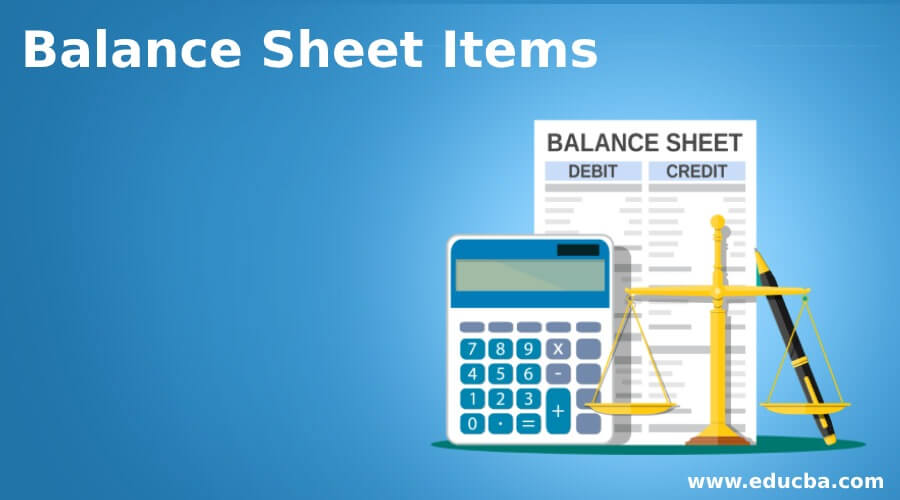Updated July 20, 2023
What is Balance Sheet Items?
The term “balance sheet items” refers to all the records captured in the balance sheet in the form of assets and liabilities as of a certain reporting date.
It is important to note that the balance sheet is one of the three fundamental financial statements (the other two being the income statement and cash flow statement). Financial analysts use it predominantly for the purpose of both accounting and financial modeling.
The balance sheet items can be broadly divided into current assets, non-current assets, current liabilities, non-current liabilities, and shareholders’ equity. Typically, the balance sheet places assets on the left and liabilities on the right. Further, when preparing a balance sheet, it is customary to place assets in decreasing order of liquidity, followed by liabilities, and then equity.
Items of Balance Sheet
Now, let us discuss some of the most common and major items in a balance sheet:
1. Current Assets
- Cash & Cash Equivalents: As it is considered the most liquid form of assets, it is placed at the top left corner of the balance sheet. Cash equivalents are typically combined with cash on the balance sheet because they primarily consist of assets that have maturities of less than 3 months or can be readily liquidated. Examples of cash equivalents include marketable securities.
- Accounts Receivable: It represents the number of sales executed on credit and not collected as on the balance sheet date. It is customary to present the balance sheet net of all provisions made to cover doubtful accounts, which accounts for a high probability of them becoming bad debts. If entities can recover the receivables, then the value of accounts receivable goes down while cash increases.
- Inventory: It represents the amount of money invested in the business in the form of finished goods, work-in-progress goods, and raw materials. When sales are recognized, then the value of this account is transferred to the income statement in the form of the cost of goods sold as per the concept of matching principle.
- Prepaid Expenses: These consist of all those expenses that a company has already paid but has not availed the services against the payment till the balance sheet date. Examples of prepaid expenses include advance payment for an insurance policy, salary paid to workers in advance, etc.
2. Non-Current Assets
- Plant, Property, and Equipment (pp&e) accounts for all the tangible fixed assets on a company’s book. Examples of PP&E primarily include buildings, equipment, and land.PP&E is recorded on the net of depreciation except for land, which is an exception.
- Intangible Assets: These account for all a company’s intangible fixed assets. These assets can be categorized into identifiable and unidentifiable intangible assets. Patents and licenses are identifiable intangible assets, while brand value and goodwill are unidentifiable.
3. Current Liabilities
- Accounts payable: It represents the dollar value of the money a company must pay suppliers for goods purchased, or services availed on credit. The value of accounts payable and cash accounts decreases simultaneously as the creditors are paid off.
- Unearned revenue: It accounts for the revenue for which payment has been received, but the service or product is yet to be delivered as on the balance sheet date.
- Notes payable: It includes the creditors that are not part of the accounts payable and are due within a year’s time. However, there are instances where notes payable appear as part of non-current liabilities as their maturity is of more than one year.
- Current portion of long-term debt (CPLTD): This account represents the long-term debt that must be paid off within a year. This head captures the principal repayment due next year, deriving from the debt amortization schedule. This account separately represents and includes it as part of the long-term debt under non-current liabilities.
4. Non-Current Liabilities
- Bonds Payable: It represents the value of the bonds the company has issued, remaining outstanding as on the balance sheet. The bonds can be either coupon-paying or zero-coupon.
- Long-Term Debt: CPLTD represents the remaining long-term debt when captured under current liabilities. Otherwise, it is the aggregate of all long-term debts, primarily term loans.
5. Shareholders’ Equity
- Share Capital: It represents the amount of money invested by the shareholders in the company. The share capital is categorized into – authorized and paid-up share capital. Authorized share capital indicates the maximum number of shares a company can issue. At the same time, paid-up share capital represents the number of shares issued to the shareholders. Usually, paid-up share capital remains stable over the period of time until there are subsequent rounds of equity infusion to fund business requirements.
- Retained Earnings: It represents the portion of the net income retained in the company’s books over a period of time. If the company generates a profit, this account receives the remaining net income after the dividend payment. However, in the case of losses, it results in the deterioration of retained earnings.
Conclusion
So, it is important that as an analyst or an investor, you know what each of the line items of a balance sheet denotes. Interlinking all the items in the balance sheet is important because it closely connects with the income and cash flow statements. To interpret the various accounting adjustments in financial reporting, one should be thorough with the line items in each financial statement.
Recommended Articles
This is a guide to Balance Sheet Items. Here we also discuss balance sheet items and the most common and major items in a balance sheet. You may also have a look at the following articles to learn more –




